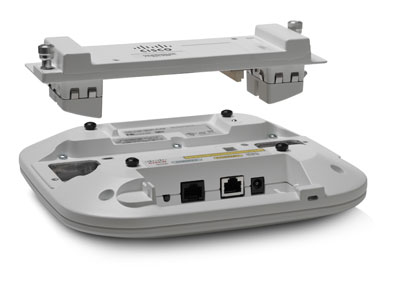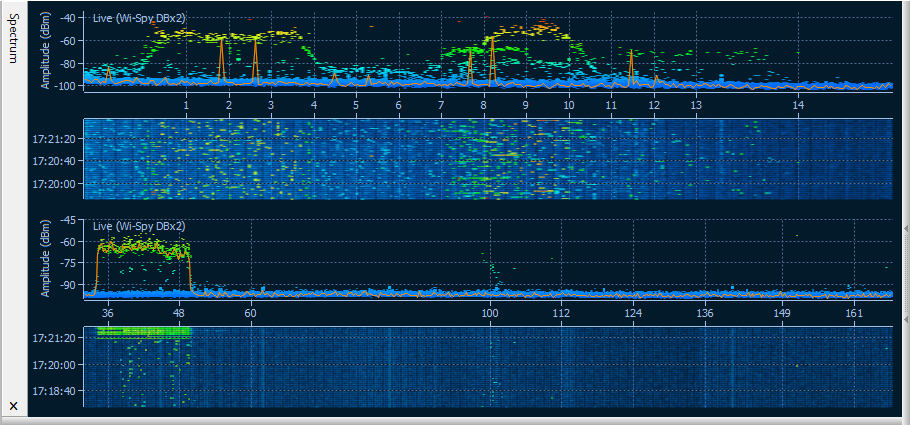802.11ac network for the most daring

On Habré often write articles "for the smallest." We, for a change, decided to write an article "for the most courageous." For those persistent in spirit, fearless, experienced wolves-IT people who are ready to risk the budget and reputation and deploy a corporate 802.11ac network now, while the standard has not even been ratified yet, and the choice of equipment is not too wide.
')
What for?
Indeed, why do we need these adventures when there is 802.11n? Firstly, perhaps, the object in general does not yet have a Wi-Fi network and there is a great temptation to make it immediately on the newest equipment. Secondly, the network may be, but old, on 802.11 a / b / g. Thirdly, it may be 802.11n, but single-band, only at 2.4 GHz, and this part of the spectrum is extremely overloaded, especially if your office is not a lonely hut in a dense forest (and even then, if there is external video surveillance around the hut on wireless cameras, the spectrum can be well littered). Fourthly, the 802.11ac standard has delicious “buns” compared to 5 GHz 802.11n networks. We already wrote about the buns on Habré in detail and correctly , so we will not repeat, but let's talk about the practice: what to choose from and how to build.
Access points
All vendors of enterprise-class wireless equipment (we will not discuss home solutions, this is a completely different niche) are in a hurry to launch 802.11ac products on the market. The market leader, Cisco, was in such a hurry to stake out a place that it released the Cisco Aironet 3600 Series a year ago, announcing support for 802.11ac at these access points, but without including a corresponding radio module. They promised to provide the module “later” (yes, such an interesting marketing move: buy an automatic rifle today, and we will deliver a sub-barrel grenade launcher to it later). I must say that they did not deceive, in April 2013, Cisco began shipping the module, which is quite easily inserted into the access point.

At the same time, they are not going to stop: after a year and a half, a second wave module (Wave 2) is promised, with support for MU-MIMO and up to 6.9 Gbps, which means a channel width of 160 MHz and 8 spatial streams. Again, if we talk about real rates between an individual client and an access point, then the bottleneck will be the clients. 8 spatial streams for one client are from the realm of fiction, but 802.11ac is just that good because excess spatial streams do not “disappear”, but are used in MU-MIMO to serve other clients:

On the heels of Cisco comes Aruba with its 220th series , with ill-concealed pleasure talking about how their access points tear Cisco access points into small pieces in real performance tests, and at a price too. Motorola has released AP 8232 , a rather interesting access point of a modular architecture (for example, you can insert a WIPS module). Beloved outside the United States, Ubiquiti began shipping UniFi AP AC . A bit late in the race Ruckus Wireless and Aerohive, who have not yet had time to start selling 802.11ac equipment.
The general trend is the first wave (3x3 MIMO, 80 MHz channels) today or, as a last resort, tomorrow, the second wave next year. By the way, another noticeable trend is the rejection of controllers in favor of the cloud. The pioneers here were Aerohive and Meraki (the latter was purchased by Cisco), all the others are gradually tightening up. The cloudy trend is not directly related to 802.11ac. Rather, the increased data rates, traffic volumes and the very rapid growth of Wi-Fi infrastructure are pushing the cloud.
The client is not always right
What do we have today in the area of client devices? Not too much yet. The first wave is adapters with a channel bandwidth of 80 MHz, mainly with support for two spatial streams, for example, the Netgear A6200 and the D-Link DWA-182 (both on the Broadcom chipset). For such adapters, the theoretical limit of PHY rate is 866.7 Mbps, and this will surely be largely written on the box, but a modestly silent fact that spoils the whole picture is a USB 2.0 bus with a maximum theoretical data transfer rate of 480 Mbps. In practice, under ideal conditions, USB 2.0 adapters do not provide real data transfer speed (i.e. throughput) above 230 Mbps. At the next stage of the evolutionary ladder, USB 3.0 models appear, with the same 80 MHz channel width and two streams, for example, the ZyXEL NWD6605 , Edimax EW-7822UAC and the Linksys WUSB6300 (all three on the Realtek chipset). Due to the adequate speed of the bus, you can expect throughput at the level of 380-500 Mbps. Well, at the top level are mPCIe adapters integrated into laptops, some already with three streams, which allow you to achieve a real speed of 550-750 Mbps. However, we note that there are very few laptops with 802.11ac.
What can we expect from customers in the future? Apparently, low-end clients will be single-threaded, high-end will remain three-threaded. The channel width is likely to reach 160 MHz. Why are there so few spatial streams, why not 4 or 8? The answer lies mostly in the field of energy consumption. Each additional stream is an additional radio path that increases energy consumption (unlike, by the way, the channel width, which has almost no effect on power consumption). A three-flow smartphone will drain the battery very quickly. Those who are interested in the details of the power consumption of MIMO devices, refer to an interesting study .
Are planning
At present, two ways to plan Wi-Fi networks are most common: “access point on a stick” (AP-on-a-stick) and creating a virtual model. The first method involves placing a single test access point (usually on a pole, so that the height corresponds to the height of the future permanent access point), measuring the signal, moving to a new position, measuring again, and so on, until complete satisfaction of the signal level over the entire area occurs and from plan compliance with capacity, redundancy, etc. The signal is measured and marked on the plan, usually with the help of network survey software (site survey), although there are still people who like to draw numbers in a notebook.
The second method is much more progressive - the program creates a virtual room model, with virtual walls and other obstacles:

Virtual access points are located and configured on the plan. You can configure the 802.11 standard channel, channel width, antenna type, etc. The process is interactive: bad placement can be easily corrected. What is the difference between 802.11ac planning and previous generation networks? Let's talk about it.
Coating
802.11ac has less coverage than 2.4 GHz networks for two reasons: (a) the higher the frequency, the higher the free space loss, (b) the drop in signal power for many materials depends on the frequency and depends on ... not the benefit of high frequencies, alas :-) For example, a solid wood door reduces the signal level by about 6 dB for 2.4 GHz and by 10 dB for 5 GHz. Why are there a door, a well-fed employee and he can reduce the signal by a few dB. Is less coverage a problem? We do not think so. Now almost do not build networks, with the main goal of coverage (coverage); all concerned capacity (capacity). BYOD walks around the planet, in offices a huge number of client devices, and the fact that a single access point in an office can “finish off” to the farthest corners does not warm anyone: it still cannot pull 20 laptops and 20 smartphones. So in a nutshell, 802.11ac equipment is tighter than older standards.
Channels
Although the number of non-overlapping channels in the 5 GHz band is much more than in the 2.4 GHz band (there are only three of them, as we know), the new wide 802.11c channels do not give you complete freedom. The place is still not enough. The list of allowed channels depends on the country , but even in countries with the widest range of channels, about 160 MHz channels can be forgotten if we are not talking about the above-mentioned hut with one access point.

With not very dense placement, you can use 80 and 40 MHz channels, with dense - channels 20 and 40 MHz. Will there be interference? It all depends on the environment and on how many channels you can use (by the way, we could not reliably determine the situation in Russia: according to one data, you can use channels 36-48, according to others - 36-64; if someone knows the exact Answer - tell in the comments). If we assume, for example, that only 36-48 are allowed, then we have only one 80 MHz channel or two for 40 or four for 20. Not at all; The illustration (at the bottom) shows a typical spectrum picture that the analyzer shows if the 802.11ac client actively communicates with accurate access on a 80 MHz channel (and literally one line of shameless self-promotion: we recently started selling USB spectrum analyzers in Russia bundled with TamoGraph Site Survey for planning and inspecting Wi-Fi networks):

On the waterfall view it is clearly visible that the channel is completely clogged. In such a situation, of course, it is wise to use narrower channels. By the way, since the 802.11ac access points used will most likely be dual-band, spectrum analysis in the 2.4 GHz band will also be helpful. A significant proportion of customers, especially mobile ones, are still limited to one 2.4 GHz band and they also need to take care of high-quality communications. In the 2.4 GHz band, interference is often caused not by Wi-Fi equipment, but by other sources.
And what is the advantage in using 802.11ac compared to 802.11n in conditions where it is not possible to use wide channels, you ask? First, the new 256-QAM modulation will give, for example, 400 Mbps at 40 MHz and two streams where 802.11n gave only 300 Mbps. Secondly, in 802.11n devices can not dynamically change the width of the channel, depending on external conditions. But in 802.11ac it is a part of the standard, and a really working part of it, which we checked by field tests. The client and the access point can start with the 80 MHz channel under good conditions, and then smoothly switch to 40 or 20 MHz if interference occurs. In addition, the transition to narrower channels and occurs when the signal level does not allow to support work on a wide channel. The narrower the channel and the smaller the spatial streams, the lower the signal level requirements: for example, according to the 802.11ac standard, the 80 MHz channel requires at least -76 dBm for the lowest rate (MCS 0), and the 20 MHz channel requires -82 dBm. In other words, at the edge of the coverage area, customers will switch to narrower channels.
Profit?
All profit and loss are summed up very well in the article to which we referred above. Whether high data transfer speeds, high network capacity, greater coverage (compared to 802.11n at 5 GHz), dynamic channel width and other delights of 802.11as outweigh its disadvantages such as equipment cost, limited technology choice and youth are weighed did not try to solve in this article. We just wanted to outline the path for the brave :-) If you are careful, wait. Clean you air!
Source: https://habr.com/ru/post/194116/
All Articles